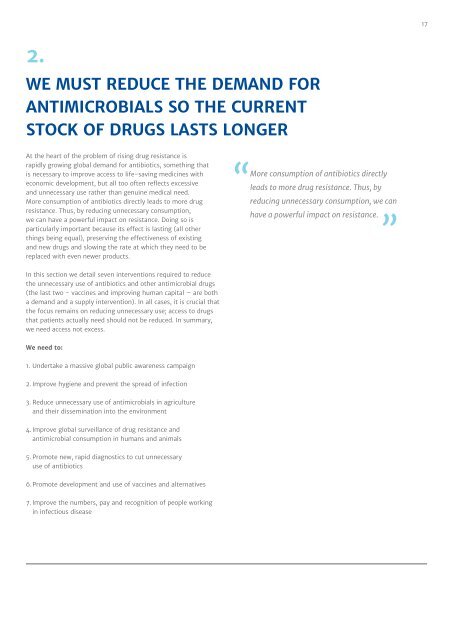TACKLING DRUG-RESISTANT INFECTIONS GLOBALLY FINAL REPORT AND RECOMMENDATIONS
qQvJ300ETXu
qQvJ300ETXu
You also want an ePaper? Increase the reach of your titles
YUMPU automatically turns print PDFs into web optimized ePapers that Google loves.
17<br />
2.<br />
WE MUST REDUCE THE DEM<strong>AND</strong> FOR<br />
ANTIMICROBIALS SO THE CURRENT<br />
STOCK OF <strong>DRUG</strong>S LASTS LONGER<br />
At the heart of the problem of rising drug resistance is<br />
rapidly growing global demand for antibiotics, something that<br />
is necessary to improve access to life-saving medicines with<br />
economic development, but all too often reflects excessive<br />
and unnecessary use rather than genuine medical need.<br />
More consumption of antibiotics directly leads to more drug<br />
resistance. Thus, by reducing unnecessary consumption,<br />
we can have a powerful impact on resistance. Doing so is<br />
particularly important because its effect is lasting (all other<br />
things being equal), preserving the effectiveness of existing<br />
and new drugs and slowing the rate at which they need to be<br />
replaced with even newer products.<br />
“More consumption of antibiotics directly<br />
leads to more drug resistance. Thus, by<br />
reducing unnecessary consumption, we can<br />
have a powerful impact on resistance.<br />
”<br />
In this section we detail seven interventions required to reduce<br />
the unnecessary use of antibiotics and other antimicrobial drugs<br />
(the last two - vaccines and improving human capital – are both<br />
a demand and a supply intervention). In all cases, it is crucial that<br />
the focus remains on reducing unnecessary use; access to drugs<br />
that patients actually need should not be reduced. In summary,<br />
we need access not excess.<br />
We need to:<br />
1. Undertake a massive global public awareness campaign<br />
2. Improve hygiene and prevent the spread of infection<br />
3. Reduce unnecessary use of antimicrobials in agriculture<br />
and their dissemination into the environment<br />
4. Improve global surveillance of drug resistance and<br />
antimicrobial consumption in humans and animals<br />
5. Promote new, rapid diagnostics to cut unnecessary<br />
use of antibiotics<br />
6. Promote development and use of vaccines and alternatives<br />
7. Improve the numbers, pay and recognition of people working<br />
in infectious disease


